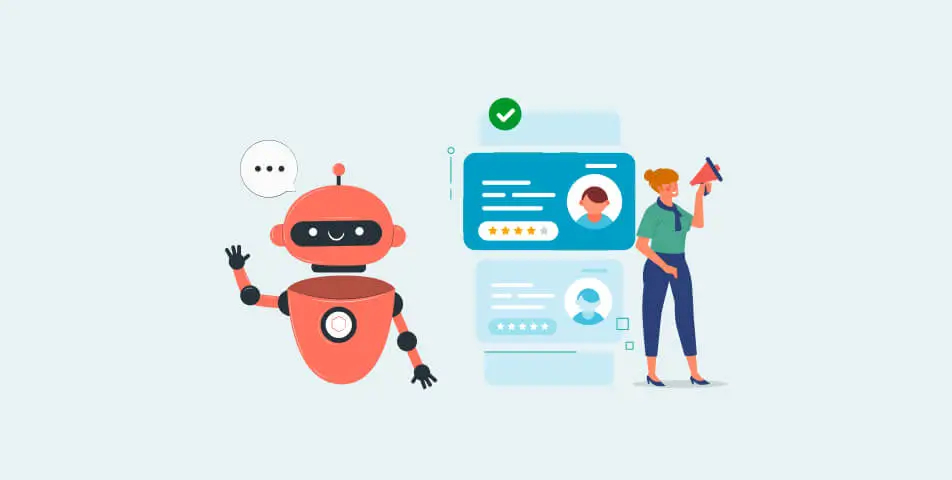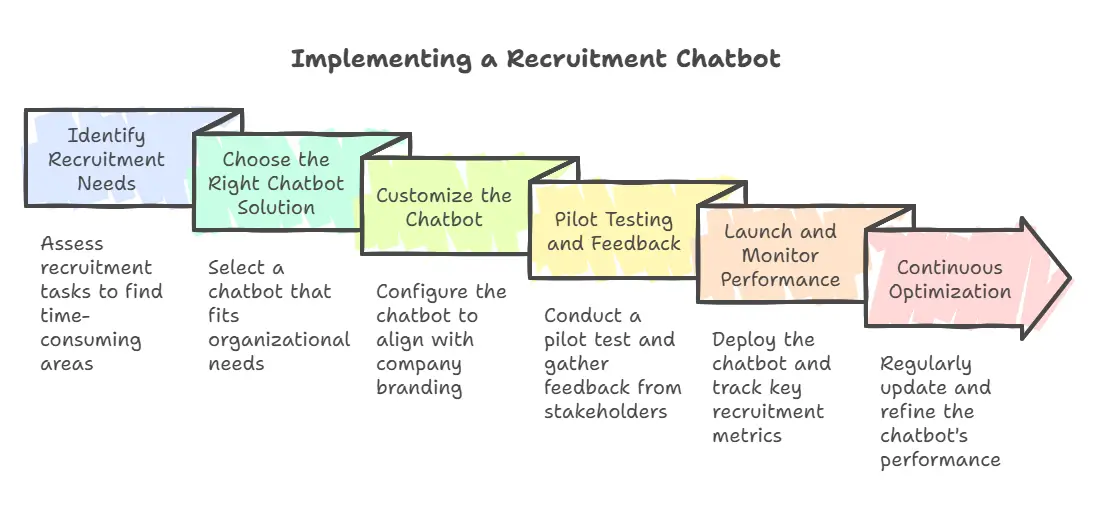Recruitment chatbots simplify the hiring process by automating tasks like candidate pre-screening, answering queries, and scheduling interviews. These AI-powered tools improve the recruitment process, enhance candidate engagement, and free up human recruiters to focus on finding the most qualified candidates.
In this post, we’ll explore how recruitment chatbots work, their benefits, and how they fit into modern recruitment strategies to improve employer branding, attract passive candidates, and boost employee retention.
Understanding Recruitment Chatbots

Recruitment chatbots are AI-powered tools that automate various stages of the recruiting process, making the overall hiring process faster and more efficient. By leveraging natural language processing (NLP) and machine learning, these bots simulate human conversation to interact with job seekers, answer candidate queries, and streamline tasks like scheduling interviews.
Key Functions of Recruitment Chatbots
- Candidate Pre-Screening
Recruitment chatbots screen candidates by assessing their qualifications against job requirements. They gather information about skills, experience, and availability to identify the most qualified candidates for a particular position. This reduces the burden on human recruiters during the initial stages. - Answering Candidate Queries
A well-designed recruitment chatbot can handle a wide range of questions from career site visitors. These bots assist candidates by providing details about job postings, company culture, and application status—enhancing the candidate experience. - Scheduling Interviews
Chatbots automatically schedule interviews with qualified candidates by syncing with the recruitment team’s calendar. This eliminates back-and-forth communication, saving recruiters time and ensuring a seamless scheduling process. - Candidate Engagement and Sourcing
By engaging passive candidates through social media channels and career sites, chatbots expand the talent pool. They encourage job seekers to apply and ensure positive candidate engagement throughout the application process.
Benefits Over Traditional Recruitment
Unlike traditional methods, recruitment bots work 24/7 to interact with candidates, ensuring no inquiries are missed. They integrate with tools like applicant tracking systems (ATS) to optimize recruitment metrics and improve the overall hiring experience for HR professionals, hiring managers, and job seekers alike.
Benefits of Recruitment Chatbots for [ICP]
Recruitment chatbots bring significant advantages to SaaS companies, SMEs, customer support teams, e-commerce businesses, and other SMBs. These AI-powered tools streamline recruiting tasks, improve hiring outcomes, and enhance both candidate and recruiter experiences.
1. Efficiency in Screening and Shortlisting
Recruitment chatbots speed up the screening process by evaluating multiple candidates simultaneously. They assess candidates against predefined criteria, shortlist candidates for further consideration, and save recruiters time by eliminating unqualified applicants early. This allows HR teams to focus on conducting initial interviews with the most qualified candidates.
2. Improved Candidate Engagement
A recruiting chatbot boosts candidate engagement by providing instant responses to queries, assisting candidates through the application process, and keeping them updated about their status. By answering candidate queries 24/7, they ensure no job seeker is left in the dark, creating a positive candidate experience and boosting employer branding.
3. Automation of Scheduling Interviews
By integrating with calendars and tools like an applicant tracking system, recruitment bots can automatically schedule interviews, saving recruitment teams hours of coordination. They handle multiple candidates simultaneously, ensuring an efficient and seamless interview scheduling process.
4. Cost Savings and Scalability
For growing businesses like SaaS companies or SMEs, recruitment chatbots reduce hiring costs by automating repetitive tasks. They scale recruitment efforts efficiently, whether sourcing candidates for a single role or filling vacant positions across various departments.
5. Enhanced Employer Branding
A well-designed recruitment chatbot provides a modern, tech-savvy impression to job seekers. By creating a streamlined, AI-driven hiring process, companies enhance their reputation as innovative employers who value candidate experience.
6. Support for Passive Candidate Engagement
Recruitment chatbots can source passive candidates from social media channels and job boards, encouraging them to explore job openings. They use personalized messaging to engage candidates who may not actively be searching, expanding the talent pool for talent acquisition teams.
7. Data Insights and Recruitment Metrics
By collecting and analyzing data throughout the hiring process, chatbots help HR teams optimize recruitment strategies. They track performance metrics like time-to-hire, candidate satisfaction, and sourcing effectiveness to refine the recruitment process over time.
Implementing a Recruitment Chatbot: Steps and Considerations

Adopting a recruitment chatbot requires thoughtful planning to ensure it aligns with your recruitment strategy and enhances the hiring process. Here’s a step-by-step guide to implementing a chatbot effectively:
1. Identify Recruitment Needs
Begin by assessing your recruitment process. Determine which tasks, like candidate pre-screening, answering candidate queries, or scheduling interviews, take up the most time. This will help you identify where a recruitment bot can bring the most value.
2. Choose the Right Recruitment Chatbot Solution
Select a chatbot solution tailored to your organization’s needs. Look for features like:
- Integration with your applicant tracking system and other HR tools.
- AI capabilities such as natural language processing and machine learning.
- Support for multiple languages and social media channels to reach a broader pool of candidates.
- Scalability to handle various recruiting tasks as your organization grows.
3. Customize the Chatbot
A well-designed recruitment chatbot should reflect your company’s branding and tone.
- Configure it to handle specific tasks like screening candidates for particular positions or answering job-related queries.
- Ensure compliance with data privacy regulations to safeguard candidate information.
4. Pilot Testing and Feedback
Before rolling out the chatbot, run a pilot program to identify any issues. Involve HR professionals, hiring managers, and even job seekers to gather feedback. This helps fine-tune the bot for optimal performance in real-world scenarios.
5. Launch and Monitor Performance
Deploy the chatbot across your career site, job boards, and other platforms. Monitor key recruitment metrics, such as:
- Number of candidates screened.
- Time saved in the pre-screening process.
- Feedback on candidate experience and engagement.
6. Continuous Optimization
Recruitment bots powered by artificial intelligence learn and improve over time. Regularly review performance data, update FAQs, and refine responses to address candidate concerns better.
Best Practices for Using Recruitment Chatbots
To maximize the benefits of a recruitment chatbot, follow these best practices to ensure a seamless integration into your recruitment strategy:
1. Set Clear Objectives
Define specific goals for your chatbot. Whether it’s improving candidate engagement, streamlining the pre-screening process, or reducing time-to-hire, having clear objectives helps measure success and guide implementation.
2. Balance Automation with Human Interaction
Recruitment chatbots are great for automating repetitive tasks like candidate pre-screening and scheduling interviews, but certain aspects of the hiring process still need a personal touch. Tasks like conducting initial interviews or evaluating soft skills such as communication skills are best left to human recruiters.
3. Ensure a Positive Candidate Experience
A chatbot’s tone, responsiveness, and ability to provide accurate information can significantly impact candidate experience.
- Use natural language processing to make conversations feel more human.
- Provide timely updates and feedback to job seekers about their application status.
- Customize messages to enhance your employer branding.
4. Regularly Update and Train the Chatbot
Recruitment processes evolve, and so should your chatbot. Update its database regularly with new job postings, FAQs, and changes in the application process. Train the bot to handle new scenarios and respond accurately to candidate queries.
5. Integrate with Existing Tools
Ensure your recruitment bot integrates smoothly with your applicant tracking system, HR platforms, and social media channels. This creates a cohesive workflow that supports every stage of the recruiting process.
6. Prioritize Data Privacy and Security
Chatbots handle sensitive information from job seekers, such as resumes and contact details. Ensure your recruitment chatbot complies with data protection laws to safeguard candidate information and build trust.
7. Engage Passive Candidates
Recruitment chatbots can be used to connect with passive candidates by engaging them through career sites and job boards. Use personalized messaging to draw their attention to suitable job openings and encourage them to apply.
8. Measure and Optimize Performance
Track metrics such as:
- Number of candidates screened.
- Time saved in handling candidate queries and scheduling.
- Feedback on chatbot interactions.
Analyze this data to refine the chatbot’s performance and identify areas for improvement.
Case Studies: Success Stories from Relevant Industries
Recruitment chatbots have transformed hiring processes across various industries. Here are a few success stories that highlight their impact:
1. SaaS Companies: Reducing Time-to-Hire
A SaaS company struggling with high volumes of job postings used an AI-powered chatbot to automate the screening process. The bot identified qualified candidates and scheduled interviews, cutting the average time-to-hire by 40%. The company also improved its recruitment metrics by engaging career site visitors and reducing drop-off rates during the application process.
2. E-commerce Businesses: Scaling Seasonal Hiring
An e-commerce business facing seasonal surges implemented a recruiting chatbot to streamline the recruiting process for temporary roles. The bot handled tasks like candidate sourcing, pre-screening, and interview scheduling. By automating these steps, the company hired over 500 temporary employees in just two weeks, ensuring smooth operations during peak seasons.
3. Customer Support Teams: Enhancing Candidate Engagement
A global customer support team adopted a chatbot to improve candidate engagement. The bot provided instant responses to FAQs, answered candidate queries, and offered updates on the application status. As a result, the team saw a 25% increase in candidate satisfaction scores and stronger employer branding.
4. SMEs: Cost-Effective Hiring
An SME used a recruitment chatbot to manage the initial stages of hiring, including candidate pre-screening and shortlisting candidates. With limited HR resources, the chatbot acted as a virtual assistant, reducing recruitment costs by 30% and allowing the recruitment team to focus on interviewing candidates.
Future of Recruitment Chatbots
Recruitment chatbots are rapidly evolving, and their future holds exciting possibilities.
- Advanced AI Capabilities: Chatbots will use machine learning to analyze candidate behavior and provide deeper insights into qualifications, making the screening process even more accurate.
- Sentiment Analysis: AI-powered bots could assess a candidate’s tone and sentiment during conversations to gauge communication skills and engagement.
- Greater Personalization: Bots will further refine how they engage passive candidates, offering tailored job recommendations based on browsing history on career sites and social media channels.
- Seamless Integration: Future chatbots will integrate with a wider range of tools, from job boards to applicant tracking systems, creating a unified ecosystem for talent acquisition.
FAQs About Recruitment Chatbots
Q1: How do recruitment chatbots improve the hiring process?
A: They automate tasks like candidate pre-screening, scheduling interviews, and answering queries, saving time for HR professionals while enhancing the candidate experience.
Q2: Are chatbots suitable for all industries?
A: Yes, recruitment chatbots can be customized for industries ranging from SaaS to e-commerce, adapting to specific recruiting tasks and workflows.
Q3: How do chatbots interact with passive candidates?
A: Through personalized messaging on social media channels, career sites, and email campaigns, chatbots encourage passive candidates to explore relevant job openings.
Q4: Can chatbots help with employer branding?
A: Absolutely. A well-designed recruitment chatbot provides a modern, responsive experience for job seekers, boosting your company’s image as an innovative employer.
Q5: Do chatbots comply with data privacy laws?
A: Most recruitment bots are designed with compliance in mind, using encryption and secure systems to protect candidate data.
Conclusion
Recruitment chatbots are transforming the way organizations approach hiring. By automating repetitive tasks, enhancing candidate engagement, and improving the screening process, they save time for HR teams while delivering a positive candidate experience. For companies seeking to refine their recruitment strategy, a chatbot offers a scalable, cost-effective solution that drives better hiring outcomes.
The future of recruitment is here—are you ready to embrace it?
- About the Author
- Latest Posts
Gaurav Nagani was the Founder of Desku, an AI-powered customer service software platform.
- Email Management: Best Strategies, Tools & Tips for SaaS and Ecommerce
- Shared Inbox Guide: Definition, Benefits, Tools & Best Practices 2025
- LivePerson Pricing Exposed: What They Don’t Show You on Their Website
- Automate Customer Support with AI A Practical Guide
- Desku vs UsePylon: Which One Scales Better for Startups?


